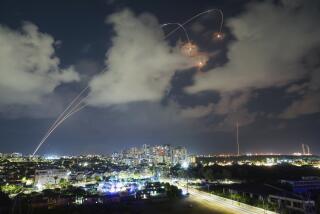Close Isn’t Good Enough
- Share via
The Pentagon blames a pair of malfunctioning sensors for Tuesday’s failure of a $100-million test of a missile interceptor system that it hopes can defend the country against intercontinental attack from rogue states. The test, which followed a claimed successful test in October, saw an interceptor rocket fired from Kwajalein Atoll in the Marshall Islands try to destroy a mock warhead launched from Vandenberg Air Force Base. It may have come very close to succeeding, but in the warhead-killing business close isn’t good enough. An interceptor must strike an incoming warhead directly. Until that feat can be demonstrated with some consistency, deployment of what’s known as a National Missile Defense system makes no sense.
Congress strongly supports development and rapid deployment of a system, as do the major Republican presidential candidates. President Clinton, while less enthusiastic, has boosted the budget for the program and promised a decision on deployment by June.
The antimissile system isn’t designed to protect against attacks from Russia or China. Using 100 or so interceptors, it aims to defend against limited attacks from such potential aggressors as North Korea and Iran, both of which are continuing to develop long-range missiles.
Russia’s huge intercontinental missile arsenal could easily overwhelm the planned system. While some incoming Russian warheads might be destroyed in flight, many others would get through. China has far fewer ICBMs, but as one of its defense officials told Times correspondent Jim Mann this week, if the United States deployed a missile defense system, China could boost its missile production to offset that deterrent.
Even though both Moscow and Beijing implicitly recognize that a U.S. system would not significantly affect the balance of power, both bitterly oppose its development. Some NATO allies too have objected, citing a “double security standard” that would leave the United States more secure than its partners. Deputy Secretary of State Strobe Talbott gave the right response: “Why would the United States be a better ally if it were vulnerable to North Korean missiles?”
A third test of the interceptor is planned for April. Then comes the decision on whether the technology is reliable enough and cost-effective enough to go ahead with deployment by 2005. If so, construction could start on radar sites in Alaska. Ultimately the program could cost up to $16 billion.
The potential missile threat from rogue states can’t be ignored. But that threat can be met only with a missile interceptor system that has been shown to work in all of its aspects. Rushing ahead with anything less would provide neither deterrence nor defense.
More to Read
Sign up for Essential California
The most important California stories and recommendations in your inbox every morning.
You may occasionally receive promotional content from the Los Angeles Times.










